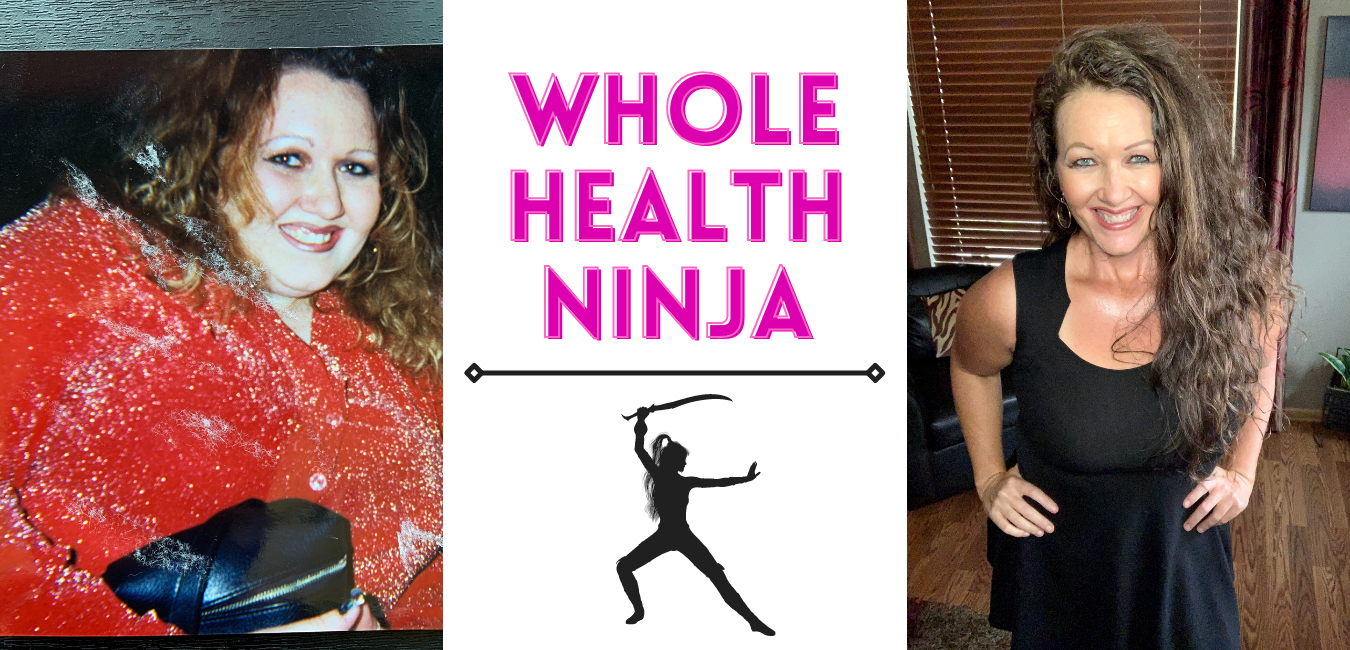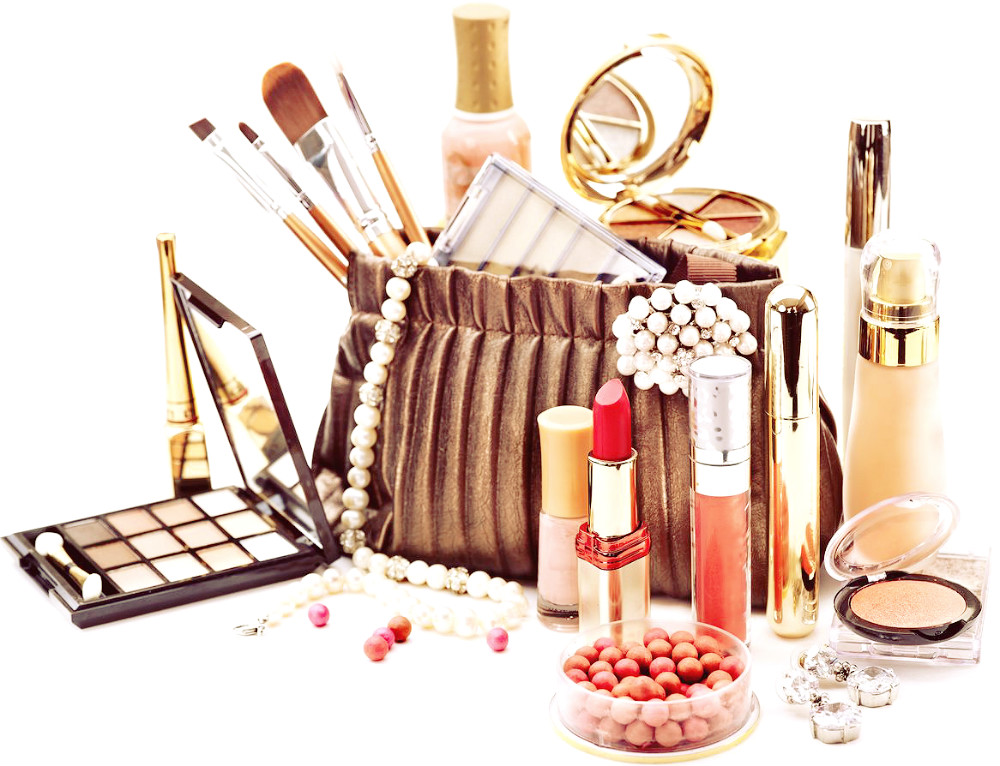It’s estimated by the Environmental Working Group (EWG) that the average American woman uses 12 beauty and/or personal care products a day, which contain 168 different chemicals. Let that sink in for a minute. Your body may be subjected to 168 chemicals a day just from your beauty and personal care routine!
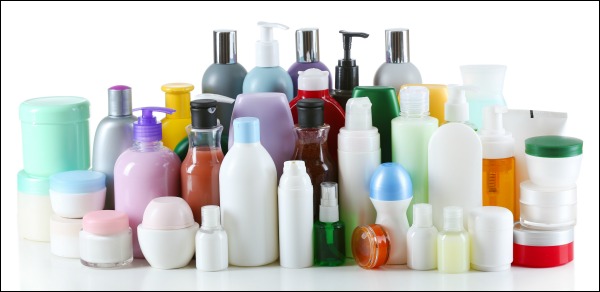
Once you know that almost 13,000 chemicals are used just to create cosmetics in the U.S., that number makes a little more sense. And here’s the kicker: cosmetic companies are not required to share any safety information with the U.S. Food & Drug Administration (FDA). So basically, the beauty and personal care industry is kind of like the wild, wild west. Anything goes.
So why is it such a big deal that you may be subjected to so many chemicals? Well, it’s estimated that it takes about 26 seconds for chemicals that are applied to your body to get into your bloodstream.
Once the chemicals are inside your body, all kinds of toxic mischief takes place and can contribute to a host of health issues like cancer, organ damage, endocrine (hormone) disruption, reproductive toxicity, neurological damage, developmental issues, skin depigmentation and serious allergic reactions.
OMG, does this mean you have to give up your makeup and walk around all smelly?
NO, absolutely not!
First, let me be clear that I’m not sharing this information to scare you. I believe that knowledge is power, and you deserve to know what’s in the products you’re spending your hard-earned dollars on and how they may be impacting your health. What you do with this information it totally up to you. I simply want to empower you with it.
Second, the good news is there are more and more beauty and personal care companies that are taking a stand and refusing to include toxic chemicals in their products. HOORAY! Unfortunately, you don’t see many of those brands lining the shelves in the mainstream big box stores where most Americans shop. But they’re out there, and I’m going to share a few with you at the end of this blog.
The other piece of good news is that it’s really easy to make a lot of beauty and personal care products yourself. Before you roll your eyes and curse me for thinking you possibly have that much time on your hands, let me make a couple confessions:
A) I am an extremely impatient person (though I’m working on that). I’m constantly looking for ways to save time and maximize the hours in my day. I simply don’t have the patience to spend endless hours making my own beauty potions, and I would never expect you to do the same.
B) I detested chemistry in high school and do not enjoy spending time on “lab” activities like making my own elixirs. Not even a little bit.
In other words, if I find DIY’ing a lot of my own beauty and personal care products to be a snap, you can probably handle it too!
I have lots of DIY formulas here on my blog and will continue to put out more and more for you. All of them are saved under the “Beauty & Personal Care” category of my blog, so it’s easy for you to find them.
What chemicals should you be looking for and trying to avoid?
Below is a list (in alphabetical order) of the most common toxic chemicals that are found in many commercial beauty and personal care products. If you see these chemicals listed in any product you’re thinking of buying, put it back on the shelf, back away slowly and then run for your life. Okay, maybe that’s a little dramatic. But you get the point.
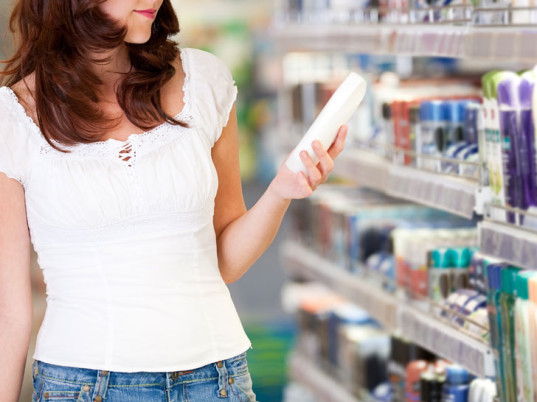
THE DIRTY LIST:
1,4-Dioxane: Found in products that create suds (like toothpaste and shampoo).
Health concern: Cancer.
What to look for on the label: Sodium laureth sulfate, PEG compounds, chemicals that include the clauses “xynol”, “ceteareth” and “oleth.”
Acrylates: Found in artificial nail products
Health concerns: Cancer, developmental and reproductive toxicity, organ system toxicity, cellular and neurological damage and irritation.
What to look for on the label: Ethyl acrylate: Acrylic acid ethyl ester, ethyl propenoate, EA; ethyl methacrylate: ethyl methacrylate, ethyl ester, methacrylic acid, ethyl ester, ethyl 2-methyl-2-propenoate, EMA; methyl methacrylate: Methacrylate monomer, Methyl ester of methacrylic acid, methyl-2-methyl-2-propenoate, MMA.
Benzophenone & Related Compounds: Found in lip balm, nail polish, foundations, baby sunscreens, fragrance, shampoo, conditioner, hair spray and moisturizers.
Health concerns: Cancer, endocrine disruption, developmental and reproductive toxicity, organ system toxicity and skin irritation.
What to look for on the label: Benzophenone, ingredients containing the word benzophenone (for example benzophenone-2), BP# (for example BP2), oxybenzone, sulisobenzone, sulisobenzone sodium.
Butylated Compounds: Found in lip products, hair products, makeup, sunscreen, antiperspirant/deodorant, fragrances and creams.
Health concerns: Endocrine disruption, organ-system toxicity, developmental and reproductive toxicity, cancer and irritation.
What to look for on the label: BHA, BHT (BHA stands for butylated hydroxyanisole & BHT stands for butylated hydroxytoluene).
Carbon Black: Found in multiple makeup products like eyeliner, mascara, nail polish, eye shadow, brush-on-brow products, lipstick, blush and foundation.
Health concerns: Cancer and organ toxicity.
What to look for on the label: Carbon black, D & C Black No. 2, acetylene black, channel black, furnace black, lamp black and thermal black.
Coal Tar: Found in shampoos and scalp treatments, soaps, hair dyes and lotions.
Health concerns: Cancer and organ system toxicity.
What to look for on the label: Coal tar solution, tar, coal, carbo-cort, coal tar solution, coal tar solution USP, crude coal tar, estar, impervotar, KC 261, lavatar, picis carbonis, naphtha, high solvent naphtha, naphtha distillate, benzin B70, petroleum benzin.
Ethanolamine Compounds (MEA, DEA, TEA & Others): Found in soaps, shampoos, hair conditioners and dyes, lotions, shaving creams, paraffin and waxes, household cleaning products, pharmaceutical ointments, eyeliners, mascara, eye shadows, blush, foundations, fragrances and sunscreens.
Health concerns: Cancer and organ system toxicity.
What to look for on the label: Triethanolamine, diethanolamine, DEA, TEA, cocamide DEA, cocamide MEA, DEA-cetyl phosphate, DEA oleth-3 phosphate, lauramide DEA, linoleamide MEA, myristamide DEA, oleamide DEA, stearamide MEA, TEA-lauryl sulfate.
Formaldehyde & Formaldehyde-Releasing Preservatives: Found in nail polish, nail glue, eyelash glue, hair gel, hair-smoothing products, baby shampoo, body soap, body wash and color cosmetics.
Health concerns: Cancer and skin irritation.
What to look for on the label: Formaldehyde, quaternium-15, DMDM hydantoin, imidazolidinyl urea, diazolidinyl urea, polyoxymethylene urea, sodium hydroxymethylglycinate, 2-bromo-2-nitropropane-1,3-diol (bromopol) and glyoxal.
Fragrance: Found in most personal care products including sunscreen, shampoo, soap, body wash, deodorant, body lotion, makeup, facial cream, skin toner, serums, exfoliating scrubs and perfume.
Health concerns: The International Fragrance Association (IFRA) lists 3,059 materials that are reported as being used in “fragrance” compounds. Many are linked to cancer, reproductive toxicity, allergies and other sensitivities.
What to look for on the label: Fragrance, perfume, parfum and aroma.
Homosolate: Found in sunscreen and skincare products with sun protection (SPF).
Health concerns: Endocrine disruption
What to look for on the label: Homosalate, Homomenthyl salicylate, HMS, HS; 3,3,5-trimethyl-cyclohexyl-salicylate.
Hydroquinone: Found in skin lighteners, facial and skin cleansers, facial moisturizers, hair conditioners and finger nail coating products.
Health concerns: Cancer, organ-system toxicity and respiratory tract irritation.
What to look for on the label: Hydroquinone or tocopheryl acetate.
Lead & Other Heavy Metals: Found in lip products, whitening toothpaste, eyeliner, nail color, foundations, sunscreens, eye shadows, blush, concealer, moisturizers and eye drops.
Health concerns: Cancer, developmental and reproductive toxicity, organ system toxicity.
What to look for on the label: Lead acetate, chromium, thimerosal, hydrogenated cotton seed oil, sodium hexametaphosphate. (Note: products that contain contaminant metals will not list them on ingredient labels.)
Methylisothiazolinone and Methylchloroisothiazolinone: Found in shampoo, conditioner, hair color, body wash, lotion, sunscreen, mascara, shaving cream, baby lotion, baby shampoo, hairspray, makeup remover, liquid soaps and detergents.
Health concerns: Inhalation toxicity (lungs), allergies and neurotoxicity.
What to look for on the label: Methylisothiazolinone (MIT): 2-methyl-4-isothiazoline-3-one, Neolone 950 preservative, MI, OriStar MIT and Microcare MT. Methylchloroisothiazolinone (CMIT): 5-Chloro-2-methyl-4-isothiazolin-3-one and MCI.
Nail Polish Remover Solvents: Found in nail polish removers.
Health concerns: Irritation of the skin, eyes and lungs, organ toxicity and cancer.
What to look for on the label: Isopropyl Acetone: Methyl isobutyl ketone (MIBK), hexone, 2-pentanone; Methyl Ethyl Ketone (MEK): 2-butanone, 3-butanone, acetone; N-Methyl-Pyrrolidone (NMP): n-methyl-2-pyrrolidone, 1-methyl-2-pyrrolidone.
Nitrosamines: Found in almost every kind of personal care product.
Health concerns: Cancer, endocrine disruption and organ system toxicity.
What to look for on the label: DEA or TEA.
Octinoxate: Found in hair color products and shampoos, sunscreen, lipstick, nail polish and skin creams.
Health concerns: Endocrine disruption, reproductive and developmental toxicity, organ system toxicity.
What to look for on the label: Octinoxate, o methoxycinnamate (OMC), parsol, parsol MCX, parsol MOX, escalol, 2-ethylhexyl p-methoxycinnamate.
PABA: Found in sunscreens.
Health concerns: Endocrine disruption.
What to look for on the label: ABA, OD-PABA, padimate O, 4-aminobenzoic acid, para-aminobenzoic acid, p-aminobenzoic acid, Et-PABA, 2-ethylhexyl ester, p-carboxyaniline.
Petrolatum & Petroleum Jelly: Found in lotions and cosmetics.
Health concerns: Cancer.
What to look for on the label: Petrolatum, Petroleum Jelly, Paraffin Oil, Mineral Oil.
Polyacrylamide: Found in facial moisturizers, anti-aging products, color cosmetics, lotions, hair products, sunscreens and more.
Health concerns: Cancer, reproductive and developmental toxicity.
What to look for on the label: Polyacrylamide; acrylamide; polyacrylate, polyquaternium, acrylate.
Polytetrafluoroethylene (PTFE, Aka Teflon): Found in foundation, pressed powder, loose powder, bronzer, blush, eye shadow, mascara, shave gel, lip balm and anti-aging lotion.
Health concerns: Cancer, reproductive toxicity and endocrine disruption.
What to look for on the label: Polytetrafluoroethylene (PTFE), Polyperfluoromethylisopropyl Ether, DEA-C8-18 Perfluoroalkylethyl Phosphate, Teflon.
P-Phenylenediamine: Found in hair dyes.
Health concerns: Cancer, skin sensitization and organ system toxicity.
What to look for on the label: p-phenylenediamine, para-phenylenediamine, 4-aminoaniline; 1,4-benzenediamine; p-diaminobenzene; 1,4-diaminobenzene; 1,4-phenylene diamine.
Parabens: Found in shampoos, conditioners, lotions, facial and shower cleansers and scrubs.
Health concerns: Endocrine disruption, cancer, developmental and reproductive toxicity.
What to look for on the label: Ethylparaben, butylparaben, methylparaben, propylparaben, isobutylparaben, isopropylparaben, other ingredients ending in “paraben.”
Phthalates: Found in color cosmetics, fragranced lotions, body washes and hair care products, nail polish and treatments.
Health concerns: Cancer, endocrine disruption, developmental and reproductive toxicity.
What to look for on the label: phthalate, DEP, DBP, DEHP and fragrance.
Resorcinol: Found in hair dyes, shampoos/hair lotions, peels and in products used to treat acne, eczema and other dermatological issues.
Health concerns: Skin and eye irritant, skin sensitizer, organ system toxicity and endocrine disruption.
What to look for on the label: Resorcinol, 1,3-benzenediol, resorcin, 1,3-dihydroxybenzene(m-hydroxybenze, m-dihydroxyphenol).
Retinol & Retinol Compounds: Found in anti-aging creams and lotions, moisturizers and foundation.
Health concerns: Cancer, developmental and reproductive toxicity.
What to look for on the label: Retinol, vitamin A, retinyl acetate, retinyl palmitate, all-trans retinoic acid, tretinoin.
Synthetic Musks: Found in perfumes, colognes, and scented soap, body wash, sprays, lotions, hair products, detergents, softeners.
Health concerns: Endocrine disruption, organ system toxicity and reproductive toxicity.
What to look for on the label: Fragrance, musk ketone, musk xylene, galaxolide, tonalide.
Talc: Found in baby powder, body and shower products, lotions, feminine hygiene products, eyeshadow, foundation, lipstick, deodorants and face masks.
Health concerns: Cancer, organ system toxicity and irritation.
What to look for on the label: Talcum powder, cosmetic talc.
Titanium Dioxide: Found in sunscreen, and pressed and loose powders.
Health concerns: Cancer.
What to look for on the label: Titanium dioxide, TiO2.
Toluene: Found in nail polish and hair dies.
Health concerns: Developmental and reproductive toxicity, organ system toxicity and irritation.
What to look for on the label: Toluene.
Triclosan: Found in antibacterial soaps and detergents, toothpaste and tooth whitening products, antiperspirants/deodorants, shaving products, creams and color cosmetics.
Health concerns: Endocrine disruption and the development of bacteria that’s resistant to antibodies.
What to look for on the label: Triclosan (TSC) and triclocarban (TCC).
Want to know more?
If you’d like to do more research into the products you’re already using or considering as a future purchase, below are some great resources. You can also join forces with these organizations to take a stand against allowing harmful chemicals in your beauty and personal care products:
Environmental Working Group’s (EWG’s) Skin Deep database
Here are some fabulous “clean” options!
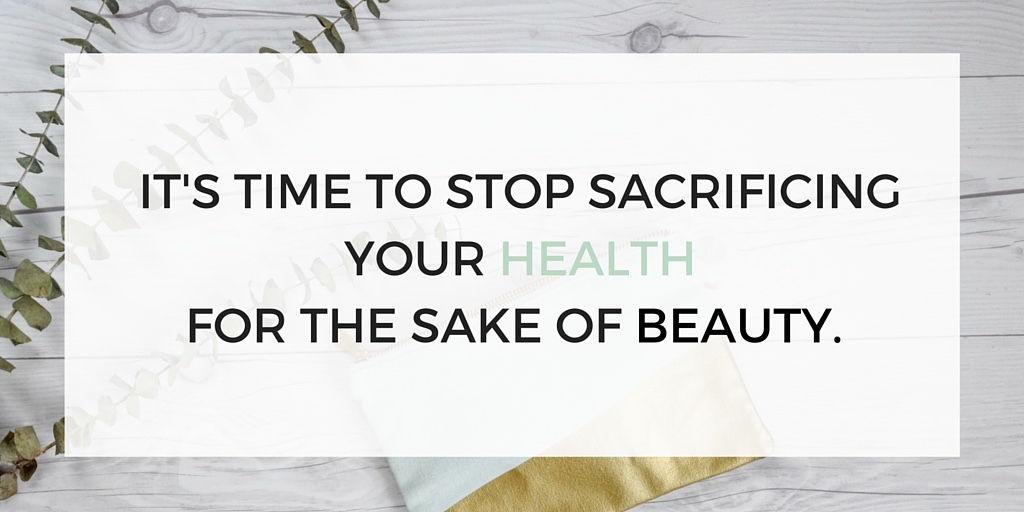
As promised at the beginning of this blog, here some great options for cleaning up your beauty and personal care routine. These companies believe firmly that your beauty should not come at the price of your health:
Suzanne Organics – offers an excellent selection of makeup and products for skincare, body care, haircare, anti-aging and tanning. Not only are these products non-toxic, they’re also formulated to enhance the health of your skin, hair, etc.
100% Pure – offers a beautiful selection of fruit-pigmented cosmetics. They also offer non-toxic personal care products.
Morocco Method – offers totally natural, luxurious haircare.
Madison Reed – offers gorgeous, high-quality hair color without toxic ingredients.
And don’t forget to check out the “Beauty & Personal Care” category of my blog, where you can find loads of DIY instructions for making your own beauty and personal care products.
Cheers to enjoying a fabulous beauty and personal care routine that doesn’t compromise your health!
With love and gratitude,
Kandi
DISCLOSURE: Any links to products above may be affiliate links, which means I earn a small commission – at no additional cost to you – if you purchase a product through them. (Click here to view my full Disclaimer & Disclosure statement.) This helps me continue providing FREE information to help you live a fit and fabulous life without busting your bank account. Thanks for your support!
